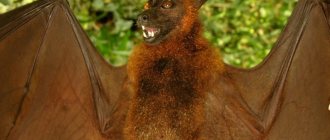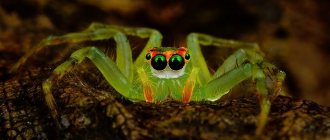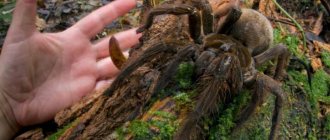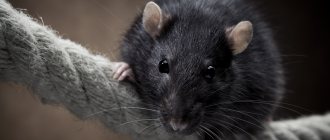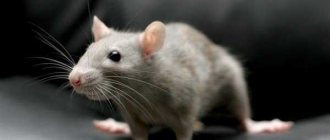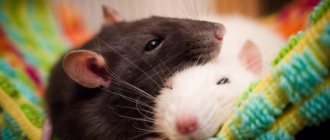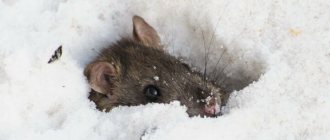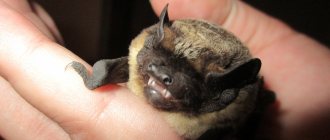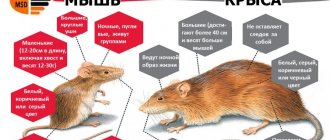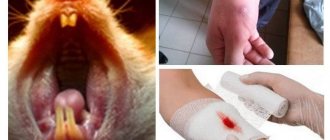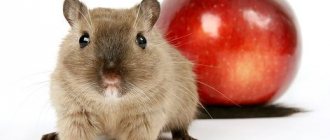The house mouse, or decorative mouse, is increasingly becoming the object of attention of people who are hesitant to buy a dog or cat. These are absolutely unpretentious animals with good adaptive qualities. They quickly become attached to their owners and never show aggression.
However, caring for pet mice has its own nuances. Therefore, before getting such a pet, it is recommended to learn more about the types, nature and features of caring for these rodents.
Interesting facts about mice
The following facts demonstrate how amazing house mice are:
- Contrary to popular belief, these decorative rodents love sweets and lard, not cheese, but eating such food is harmful.
- The mouse genome is almost 80% identical to the human genome.
- Each mouse family has its own unique smell, thanks to which rodents determine their own membership in a particular group.
- House mice have very good hearing, but poor eyesight. They perceive sounds with frequencies up to 100 kHz.
- In a stressful situation, the mouse secretes a substance with a pungent odor along with its urine. It warns relatives of danger. When other rodents sense it, they become afraid and run away.
What are rodents?
Of all mammals, the order of rodents is the most numerous. They live on almost all continents of our planet. They are absent only in Antarctica and on some oceanic islands.
Animals can differ from each other in every possible way in size, color, shape of the head and other parts of the body, as well as the thickness of the fur. The main common difference for all types of rodents is a pair of large long incisors at the bottom and top. These teeth grow throughout life, gradually grinding down on solid food. Another characteristic feature is diastema - the gap (in place of fangs) between the incisors and the remaining teeth.
Animals inhabit steppes and forests, mountainous areas, river valleys and deserts. They can lead an underground and semi-aquatic lifestyle, and some have even mastered the air (flying squirrels). Rodents feed mainly on plant foods, but some species eat insects, worms, small vertebrates and other animals.
Is it worth getting a decorative mouse at home?
A live house mouse costs 200-300 rubles. The low price is one of the reasons why many decide to get such a pet. But before you do this, it’s worth learning about all the advantages and disadvantages of keeping a decorative rodent at home.
| pros | Minuses |
| The mouse does not take up much space, does not run around the apartment, and does not damage the owner’s property | The noises made by mice at night disturb the sleep of household members |
| Decorative rodent is undemanding to living conditions | Specific smell |
| Mice are omnivores | Low intelligence of a rodent |
| Small expenses for food and maintenance | Short lifespan |
| The decorative mouse is easy to tame and does not bite. | |
| A pet gives a lot of positive emotions |
What else can you supplement your diet with?
To prevent decorative mice from having problems with teeth grinding down, in addition to the main food, it is advisable for them to occasionally gnaw on pieces of spruce and pine needles, as well as tree branches:
- aspen;
- hazel;
- apple trees;
- and you;
- rowan.
The branches should be young and juicy, with high nutritional and taste properties.
It is advisable to supplement the diet of ornamental rodents with the following products:
- boiled meat (including well-processed spongy bones and cartilage);
- egg powder (or crushed boiled eggshells);
- milk and dairy products;
- cheese (in limited quantities);
- fresh lard;
- mineral additives (chalk, salt);
- fish oil;
- yeast;
- nuts (except peanuts).
Care and maintenance of domestic mice
There is nothing difficult about caring for and maintaining decorative mice, even for a child. The conditions of detention should be as follows:
- indoor air temperature – +20…+27 degrees;
- humidity – 55-65%;
- dim lighting;
- no draft.
Attention! It is important to choose the right place for a house mouse to live. The cage should not be located near heating devices or in direct sunlight. Overheating is dangerous for the life of a rodent.
Cage and filler
Before buying a cage, you need to decide how many mice will live there. For a family of 3-4 individuals, a dwelling measuring 60x50 cm is suitable. The height can be any, but not less than 40 cm. For one house mouse, a cage with dimensions of 40x30 cm is used.
Preference is given to designs made of metal gratings with a plastic removable tray. It’s good if it has high sides, then the filler won’t spill out. The door must close securely, otherwise the decorative mice will escape.
A thick layer of wood shavings is poured onto the bottom - at least 3-4 cm. Only natural materials can be used as bedding - pressed sawdust, crushed corn cobs. Cotton wool, rags, paper are not the best option, as they do not hold back unpleasant odors and quickly get wet.
Interior design of a mouse's home
It is recommended that pet mice have a resting house. You can make it yourself from scrap materials or buy it ready-made at a pet store. A little filler is poured inside so that mice can burrow into it when they are cold or scared.
In addition to the house, you will need a feeder and water bowl, as well as a running wheel to increase physical activity. It is better to give preference to a solid structure without holes. The tail can get stuck there while running, which can lead to injury. If there is enough space in the cage, it is worth placing pipes, tunnels and ladders inside. With their help, it is convenient to connect the first level with the second.
Hygiene
Cleaning the cage of a decorative rodent is done as the litter becomes dirty. If there is only one house mouse living there, the procedure is carried out once every 5-7 days, if there are several, more often. The old filler is thrown away and new filler is added. Every time during cleaning, all equipment is washed - drinking bowl, feeder, pipes and wheel. It is better to clean the tray with a soda solution and scald it with boiling water.
Attention! An unpleasant smell in the cage appears only because the owner of a pet rodent rarely cleans the cage. This is also why mouse fur stinks.
The fur of a house mouse also needs to be looked after. It becomes contaminated with feces and urine, and pieces of food stick to it. Even if the fur smells bad and looks untidy, the decorative rodent should not be bathed. Mice cannot swim and are very afraid of water, unlike domestic rats. Dirty fur can be cleaned in other ways - with a toothbrush, a damp cotton pad or a piece of soft cloth.
Bathing a house mouse in water is allowed in exceptional cases when the contamination cannot be removed in any other way or is life-threatening. To wash your pet you will need a deep bowl. No more than 2 cm of water is taken into it. The fur is gently wetted by hand, then detergent for rodents is applied, lathered and rinsed. After thorough rinsing, the pet mouse is wrapped in a towel and held in your arms for as long as possible so that it does not catch a cold.
Taming of ornamental rodents
A house mouse is easier to tame than a hamster. The main thing in this matter is consistency and regularity of communication.
After purchasing the decorative rodent, leave it alone for a day or two. During this time, he will adapt, inspect and sniff his new home. Next, you can begin to gradually tame the mouse:
- You should approach the cage more often and talk to the rodent in a quiet and gentle voice.
- The next stage is getting used to the owner’s smell. To do this, you need to feed the mouse by hand through the grill.
- After a few days, you can try to open the door and give something tasty in the palm of your hand. The rodent will have to come and take the food on its own.
- Soon the house mouse will understand that the owner's hands do not pose a threat. She will begin to climb right into your palm and eat calmly. At such moments, you need to carefully stroke her back.
- At the final stage of taming, the decorative mouse will calmly allow you to pull yourself together. The main thing is not to scare her with sudden movements or loud noise.
To prevent a house mouse from going wild, you need to regularly communicate with it. If you don't pick it up for a long time, it will quickly wean itself off its owner.
Important! House mice love company. If an ornamental rodent lives alone in a cage, it needs to be given more attention.
Kinds
The mouse subfamily includes about three hundred species, each of which is characterized by external and behavioral features. Despite significant differences, most species have a number of similar characteristics.
Types of mice, typical features, and brief characteristics of the species are given below.
African mice
Unlike most of their relatives, African mice, whose homeland is called Tunisia, are not synanthropic species and are practically not tamed.
The body length of such a mouse is no more than twelve centimeters. The color is interesting: light brown or sandy fur has several dark longitudinal stripes. Rodents do not have a pleasant odor, which sets them apart from representatives of most other species.
The typical habitat of African rodents are burrows dug in the sand or nests made in dry grass. Their food is cereals, fruits, insects, and larvae.
The natural lifespan is about four years, but in the wild rodents can live no more than a year, due to the large number of natural enemies.
Grass mice
Grass mice live on the African continent. The body size of representatives of this species ranges from ten to seventeen centimeters.
Rodents prefer to settle in humid environments, for example, along the banks of rivers and lakes. Grass mice can build houses on their own, using dry grass, fluff, and also occupy other people's homes.
Lesnaya
A distinctive feature of wood mice is a small spot on the chest that has a yellowish tint.
These rodents are common in areas with temperate climates. Rotten stumps, dry grass, tree roots, and other voids of natural origin can serve as housing for them. Wood mice feed on cereals, insects, and berries.
Yellow-throated mouse
The yellow-necked mouse is classified as a poorly studied species listed in the Red Book.
The decline in the population of this species is due to the specific habitat; these tiny rodents, whose body length is no more than ten centimeters, live exclusively in deciduous forests.
Gerbil
The gerbil mouse fully lives up to its name, as it lives in hot deserts, semi-deserts, and steppes.
This breed of mice is distinguished by the presence of a long fluffy tail, which tends to fall off when in danger. A new one does not grow back. The diet of gerbils consists of cereals, insects, seeds, fruits, and nuts.
Gerbils can jump long distances and move on their hind legs. These rodents lead an active lifestyle during the daytime. In winter they do not hibernate, but become lethargic and inactive.
Gerbils are light brown in color, with the fur on their bellies being several shades lighter.
Harvest mouse
The field mouse lives in areas with temperate climatic conditions. The shades of the rodent's fur can vary from light brown to black; there is a longitudinal contrasting stripe on the back.
The body size of the animal is no more than ten centimeters. Mice of this species can live in urban areas. Their food sources are cereals, invertebrates, insects, fruits, and nuts.
House mouse
House mice are called synanthropic species of rodents that live close to human habitation, feed on food supplies, and prefer to spend the winter in houses and apartments.
The size of the rodent varies from eight to five centimeters. They are unpretentious to external conditions and nutrition. Life expectancy is about two years, but in good conditions the rodent can live up to four years.
Shrew
The shrew is a type of mouse that digs and also has a long, thin nose. The coat color of these animals is uniform and can vary from gray to black.
Shrews feel especially good near natural bodies of water.
Features of feeding
House mice are undemanding when it comes to nutrition. Their diet is based on dry grains and seeds. Pet stores sell ready-made mixtures with a rich composition for pet rodents. These include:
- millet;
- barley;
- wheat;
- corn;
- peas;
- buckwheat;
- sunflower seeds;
- nuts.
Find out what house mice like to eat.
Domestic mice also enjoy eating fruits and vegetables - carrots, cabbage, cucumbers, zucchini, apples and pears. Twice a week you can give rodents low-fat cottage cheese, boiled chicken breast, eggs, dried fruits and cereals. In the summer, fresh greens are introduced into the diet of domestic mice - leaves of nettle, dandelion, plantain.
Prohibited products:
- Red beetroot;
- sweets;
- bread;
- conservation;
- snacks, salty foods;
- sausage, frankfurters;
- fatty food;
- mushrooms.
To wear down their teeth, domestic mice are given twigs of fruit trees or shrubs to chew on. To compensate for the deficiency of minerals, a salt lick stone is placed in the cage. The drinking bowl should always be filled with clean water.
How to care for a white mouse at home
The white mouse has long been known as a pet. Its existence was noted before our era, approximately 3500 years ago. The first information comes from the east, from countries such as China and Japan, although many continue to believe that the appearance of these rodents was provoked by the efforts of scientists to conduct various experiments and experiments.
articles
In ancient times, mice were kept in monasteries and temples as sacred animals and were cultivated. A manifestation of this can be considered the fact that among many eastern peoples the first month of the calendar is named in her honor, although in some countries the mouse image was replaced with a rat one.
Some believed that these mammals could bring happiness. In Japan, there was a widespread belief that if you keep a white mouse in your home, it will rid the house of the attacks of its wild counterparts. In turn, astrologers in Ancient China used these rodents to make predictions.
But it was not only in the east that mice were cultured. Even if it was not whites, but brownies, they were revered in Ancient Greece. The image of a mouse was inextricably linked with the cult of Apollo, who was often depicted with a mouse sitting at his feet.
In some regions of Greece, Apollo was considered the patron saint of these rodents, and therefore they were kept in temples.
In other regions, he was considered a god who protected the homes of his admirers from the damage that these animals bring and from mouse invasions. There was even a myth about this.
Mass breeding of these animals began at the end of the 19th century, when the first batch of these rodents was imported to Europe for the purpose of scientific research. At the moment, they have become an indispensable resource for carrying out various experiments and the need for them does not fade over time.
Breeding
House mice become sexually mature at 30-35 days of age. In females, estrus begins; in males, a sign of maturation is the descent of the testes into the scrotum. It is recommended that females be mated for the first time upon reaching three months of age.
Effective mating is possible only during estrus, which occurs in females every 3-8 days and lasts from 4 to 20 hours. Pregnancy in house mice lasts 22 days.
Approximately in the middle of gestation, the female begins to build a house or nest from the litter in which the pups will be located after birth. She uses wood shavings, scraps of soft fabric, paper, and napkins as building materials. It is important to ensure that all this is at the disposal of the pregnant female.
There are from 5 to 9 mice in a litter. They are born naked, blind and deaf. The weight of a newborn mouse is 1-2 g.
Little mice develop quickly. On the third day they develop hearing, and on the fourth day their bodies are covered with soft fur. By the fifth day of life, their body weight doubles. Two weeks after birth, the eyes open. From this age, domestic mice begin to feed themselves. The young animals are weaned from their mother on the 21st-25th day.
To avoid uncontrolled reproduction, male domestic mice are separated from females.
Many people are not sure whether to get a pet mouse, because this animal has already earned a bad reputation. However, ornamental species of rodents make excellent pets - they are easy to care for, interesting to watch, mice are quickly tamed, and do not require much attention or high maintenance costs.
Are nasal drops safe during pregnancy?
Is it possible to use drops for a runny nose during pregnancy? There is a classification of rhinitis. Each type requires special treatment and an integrated approach. The reasons during the period of bearing a child are:
Viral diseases requiring immediate medical intervention. The risk of infection entering the baby’s body and amniotic fluid increases. The consequences of the pathology will be unfavorable.
- Hormonal imbalances cause vasomotor rhinitis. The cause is increased secretion of progesterone and estrogen, which provokes an imbalance of hormones, leading to a weakening of the body's defenses, thinning of the mucous membrane, swelling and hyperemia. The woman’s immune system ceases to resist pathogenic microflora. Its task is the physiologically correct formation of embryonic tissues and organs of the baby. Vasomotor (hormonal) rhinitis lasts several months. Hypoxia caused by its presence leads to a slowdown in fetal development and the formation of embryonic anomalies.
- Allergic manifestations with nasal discharge and swelling pose a serious problem for the immune system of the woman and the fetus. An allergist will identify the irritating factor after conducting a series of tests. Will select an effective nasal drug approved for use by the expectant mother.
With caution, doctors prescribe medications to women who have a tendency to increase blood pressure. The use of vasoconstrictor compounds leads to the development of a hypertensive crisis, which adversely affects the baby’s health.
Correctly selected nasal drops relieve symptoms and hypoxia. The treatment is effective and the risk of adverse effects is minimal.
Cell
The size of the cage depends on how many mice you will keep together. For a pair or small group of females, a 60 cm square cage is sufficient. Mice will appreciate a cage with several levels, as they love to climb.
Glass aquariums and wire cages are the best cage options for mice. The aquarium will have to be covered on top with a tight-fitting mesh lid and filled with devices for games and climbing.
Wire cages with horizontal bars are great because they provide plenty of climbing options and are easier to attach furniture, platforms and toys to.
Make sure the bars are not too wide, otherwise mice can escape (or get stuck trying to escape), and the door allows easy access to the entire cage. Avoid using cages with wire mesh bottoms—hard bottoms are better for their paws.
Modular plastic cages designed for hamsters are suitable for mice and their activity levels, but they are difficult to clean, sometimes poorly ventilated, and the mouse can chew through the plastic.
Place the cage so that it is constantly in your field of vision. Avoid exposure to drafts, direct sunlight and access to other pets.
Mice need to play and move a lot. They all love to spin the wheel, so add that and extra tunnels made from plastic sections of water pipes or cardboard. Your mice will appreciate the following toys:
- Wooden blocks and houses Small cardboard boxes Ladders Cotton rope Egg cartons (paper only) Small willow balls
Depending on the size of the cage, it should be cleaned regularly, especially if it is made of glass or plastic. It is best not to wait until the unpleasant odor appears, because by then it will be quite unpleasant for your pets.
On the other hand, mice mark their territory, and with frequent disinfection, the cages will become upset. You can leave some old shavings or debris to leave the smell behind, and only do a thorough cleaning and disinfection if absolutely necessary.
General characteristics of the mouse family
Science knows 519 species of rodents from the mouse family. All of them perfectly adapt to different climatic conditions, lead a similar lifestyle and have a number of identical external characteristics.
Mice can be easily distinguished from other rodents by the following parameters:
- small head with a blunt or elongated muzzle;
- large, round or barely distinguishable ears;
- small beady eyes;
- small pink nose;
- stretched body;
- thin tail, the length of which is 70-120% of the body;
- small hands of the front paws;
- hind limbs with an outstretched foot, due to which mice can jump and rise up with emphasis on their paws;
- long sharp incisors, which are located in the center of both jaws and grow throughout the life of the animals by 2 mm per day;
- hard wool, the color of which depends on the type of mouse.
